Partial Dentures
Partial Denture Services
For Missing Teeth
There are various alternative options available to replace your missing teeth. Wearing a partial denture is one of them. It is a widely accepted and successful solution but still considered as a poor substitute compared to having your own “real teeth”. Many people are satisfied with their false teeth once they have learned how to speak, eat and what type of food they can eat ……then there are people who have difficulty.
Perseverance, patience and seeking our assistance can lead to a satisfactory and good outcome. WE ARE HERE TO HELP!
What are Partial Dentures?
Partial dentures are removable dental appliances compared to fixed dental appliances such as bridges or implants which get cemented on or screwed in. Removable Partial dentures are false teeth which replace your missing real ones. You can take them out for cleaning or whilst sleeping. If you require a fixed solution such as a bridge or an implant, then you should visit your dentist who can advise you appropriately.
Types of Partial Dentures:
Let us discuss removable partial dentures in general. There are various types which are made from different materials. We will list the different types and describe the differences using simple terms. Don’t worry if it all gets a bit confusing. Once we get to see you we will explain and advise you accordingly.
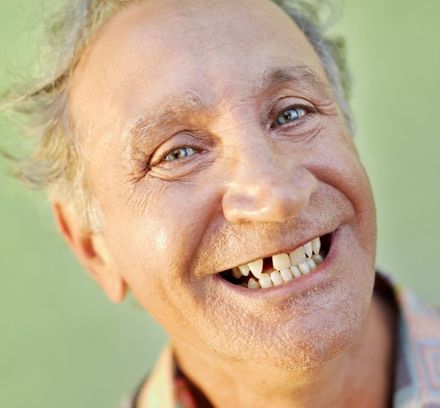
Acrylic resin (plastic) dentures:
Made from pink and rigid plastic encasing and surrounding the false teeth which are used to replace your missing natural teeth. Wire clasps (hooks, clips) are used to clamp around your own teeth to hold the partial denture in place. The clasps are made from thin wire and are bent by hand around some of your real teeth.
Advantages:
- More economical and easier to obtain (cheaper)
- Easier repaired if broken
- Can be relined (new fitting surface) on most occasions
- Quicker process to provide tooth addition upon tooth loss.
- Useful for large partial dentures when only 2-4 natural teeth are remaining
- After extraction(s) it can be used as a temporary partial denture whilst gum resorption takes place.
Disadvantages:
- Stain, tartar and plaque build up to pink plastic surfaces and around teeth is possible
- Thicker palate coverage and less room for tongue
- Usually larger coverage on palate to aid in suction
- Brittle, easy to break or bend a clasp
- Poor aesthetics as clasps and plastic borders can be seen
- Clasps and plastic borders around natural teeth can act as food traps
- With poor oral hygiene, gum inflammation can cause tooth and bone loss
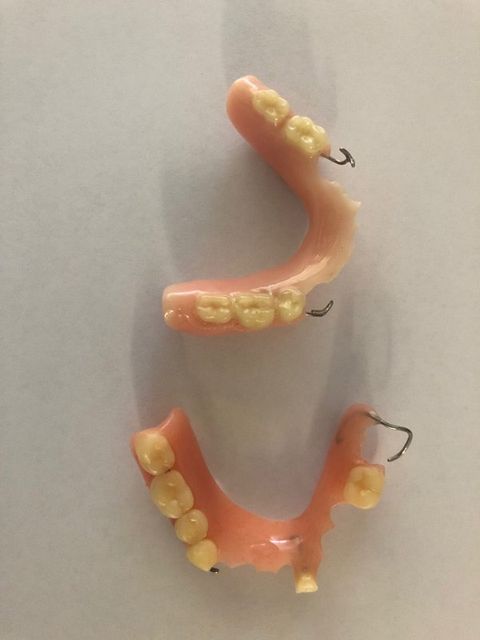
Flexible dentures
Made from pink, flexible or semi flexible material resins encasing and surrounding the false teeth which are used to replace your missing natural teeth. There are NO wire clasps (hooks, clips). Instead flexible translucent retaining arms are used to clamp around your own teeth to hold the partial denture in place. We refer to them as “invisible dentures” as the materials blend in with the colour of gums and are hard to detect.
i. Fully flexible
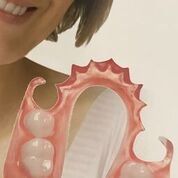
Advantages:
- Made from thermoplastic flexible pliable material
- Strong and difficult to break
- Lightweight
- Durable but thin
- Undetectable and natural looking
- Well fitting
- Smaller palate coverage
- Reasonable cost
Disadvantages:
- With a poor cleaning technique, surfaces can deteriorate and become a matt texture
- Take longer to repair or have teeth added to
- Smoking and strong spices will stain and provide odour
- With poor oral hygiene, gum inflammation can cause tooth and bone loss
ii. Semi flexible (new type)
Advantages:
- Made from semi flexible resin (PMMA) somewhat pliable material
- Durable and smooth polished surface
- Easily repaired and added too
- Undetectable and natural looking
- Easily converted to a complete denture
- Used for large unilateral coverage (mainly teeth on one side)
- Reasonable cost
Disadvantages:
- It can break
- Can stain
- Requires careful insertion and removal
- Following poor oral hygiene, gum inflammation can cause tooth and bone loss

Chrome Cobalt (metal) denture:
This type of Partial Denture is also a removal appliance, replacing several missing teeth. The frame work is made of cobalt chrome metal alloy (CoCr) and the surrounding pink resin is the gum part holding the teeth. Chrome dentures have custom fitted wire clasps to fit around your natural teeth accurately allowing for good retention.
Advantages:
- Stronger than acrylic and less likely to break
- thinner
- good longevity (no wear)
- greater dimensional stability
- less coverage across palate and soft tissue
- better heat and taste transfer
- does not rely on suction
- material is less porous and less accumulation of food
Disadvantages:
- Stiff and hard
- Poor look as metal clasps are visible
- Metal clasps touch natural teeth
- Food traps around clasps and acrylic (gum) junction
- Difficult and more expensive to repair
- Additions of extra teeth are unreliable
- Difficult or impossible to reline
- With poor oral hygiene, gum inflammation can cause tooth and bone loss
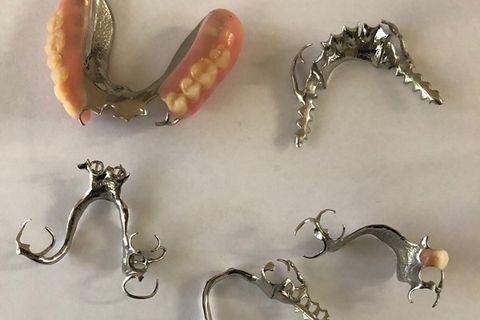
Chrome and Flexible Combo denture
Advantages:
- Combination of rigid and pliable materials used where needed
- No metal clasps showing
- Ability to use rests on teeth to avoid movement into gums
- Longevity
- Thin and strong
- Easy to clean
Disadvantages:
- More expensive
- Flexible clasps can stain or loosen
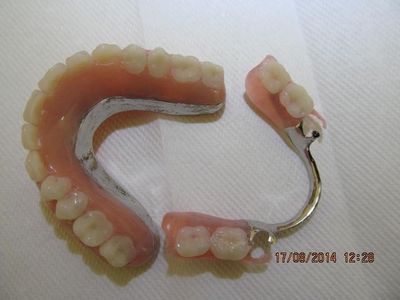
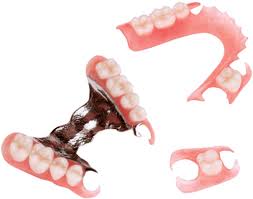
Precision denture
is removable (usually (CoCr)) but is not attached by clasps. It has internal precision attachments which are attached to corresponding crowns. The procedure is outdated and nowadays gets replaced by implants (see option 6 done in conjunction with Prosthodontist)
Implant supported Partial denture
Can be made as a removable appliance which clicks onto an implant. This type of denture requires considerable planning. We undertake this type of work in conjunction with a specialist Prosthodontist or an Oral Surgeon
Advantages:
- Good prognosis and outcome
- Excellent retention
- Excellent aesthetics and no visibility of clasps or metal hooks
- Partial denture can be self-removed for cleaning
- Withstands strong biting forces
- No pressure or stress on natural teeth as clasps don’t exist
- Good longevity
Disadvantages:
- Requires considerable planning, use of x-rays, scans etc
- Minimally invasive surgery and anaesthetic
- Considerably increased cost compared to other alternatives
- Annual maintenance to replace nylon inserts that wear out
- Tooth addition possible but can be problematic
- With poor oral hygiene peri-implantitis is possible leading to loss of bone and implant












